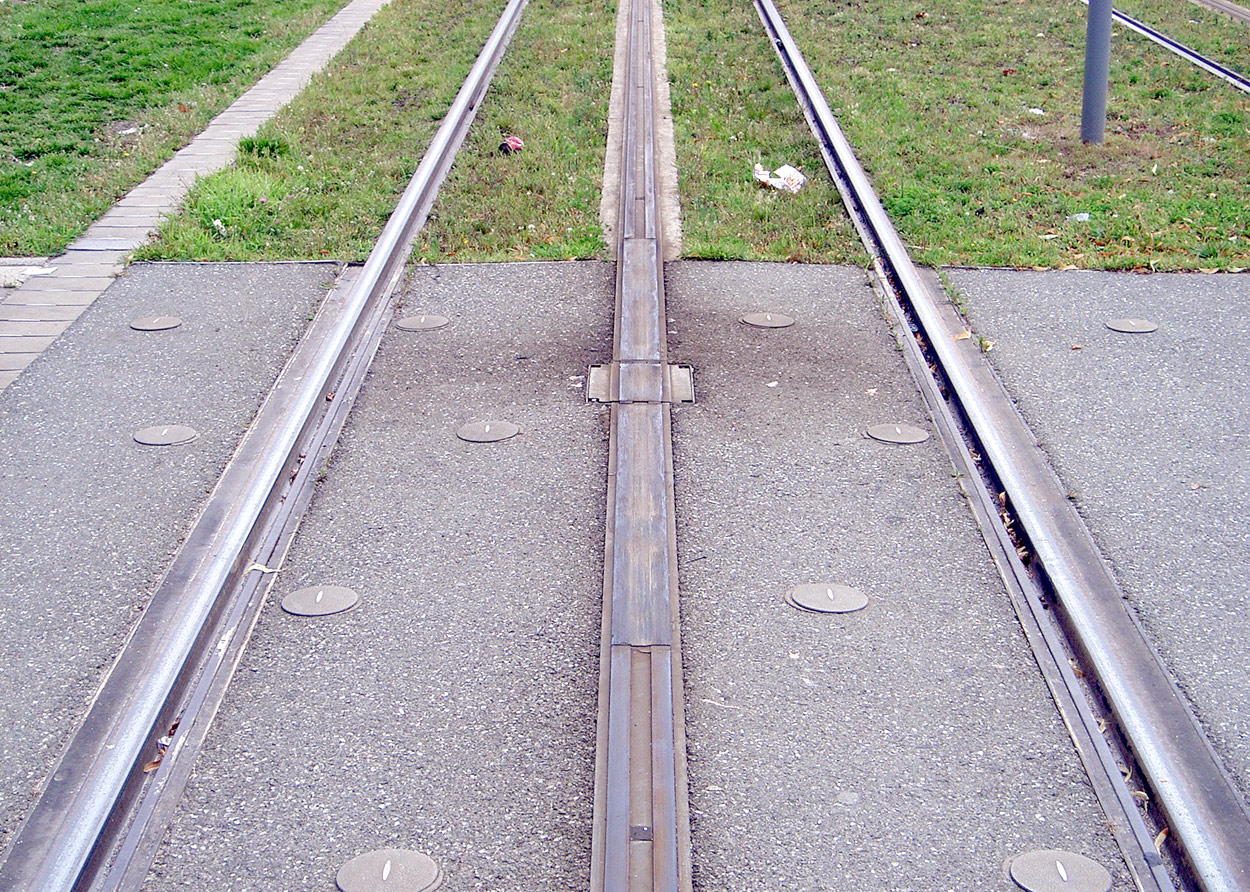- Ground-level power supply

300px|thumb|right|A section of APS track showing the neutral sections at the end of the powered segments plus one of the insulating joint boxes whichmechanically and electrically join the APS rail segmentsGround-level power supply, also known as surface current collection and Alimentation par Sol (APS) is a modern method of third-rail electrical pick-up for street
tram s. It was invented for the Bordeaux tramway, which was constructed from 2000 and opened in 2003. Currently this is the only place it is used, but there were and are proposals to install it elsewhere:*Nice (abandoned in favour of nickel metal hydride batteries)
*Edinburgh,Scotland Fact|date=December 2007
*Florence (Firenze), Italy
*Marseille ,France
*Melbourne,Australia
*Gold Coast, Queensland ,Australia
*Reims,France
*Washington, D.C ,United States
*Al Sufouh Tram inDubai ,United Arab Emirates cite news | title=Al Safouh tram project consortium selected |publisher="Railway Gazette International " |date=2008-4-29 |url=http://www.railwaygazette.com/news_view/article/2008/04/8374/al_safouh_tram_project_consortium_selected.html | accessdate=2008-05-02 ]Technology
It is used, primarily for aesthetic reasons, as an alternative to
overhead lines . It is different from theconduit current collection system which was used in historic tram systems in Washington, Manhattan and parts of London, which buried a third and fourth rail in an underground conduit (‘vault’) between the running rails.Unlike the track-side
third rail used by most metro trains and some main-line railways, APS does not pose a danger to people or animals, and so can be used in pedestrian areas and city streets.APS uses a third rail placed between the running rails, divided electrically into eight-metre segments with three metre neutral sections between. Each tram has two power collection skates, next to which are antennas that send radio signals to energise the power rail segments as the tram passes over them. At any one time no more than two consecutive segments under the tram should actually be live.
Use in Bordeaux
Modern ground-level current collection was pioneered by the recent Bordeaux tramway in
France . The public had assumed that the new system would use a traditional conduit system, like that of the Bordeaux trams which ran prior to 1958, and objected when they learned that it was not considered safe, and that overhead wires were to be used instead. Facing complaints both from the public and the French Ministry of Culture, planners developed APS as a modern way of replicating the conduit system.APS was developed by Innorail, a subsidiary of Spie Enertrans, but was sold to
Alstom when Spie was acquired by Amec. [cite news | title=Third-rail trams across the Garonne |publisher="Railway Gazette International " |date=2004-02-01 |url=http://www.railwaygazette.com/news_view/article/2004/02/961/third_rail_trams_across_the_garonne.html | accessdate=2008-05-02 ]There are 12 km of APS tramway in the three-line network of 21.3 km total length, expected to be 40 km by 2007. Sources suggest that APS adds about €100,000 to the cost of the trams, whilst the infrastructure is about 300% more expensive than overhead wires.Fact|date=September 2008 Bordeaux
Citadis tram s use pantographs and electricoverhead lines in outlying areas.Before use in Bordeaux, APS was tested and proved viable on a short section of reserved-track tramway in the French city of
Marseilles . Nevertheless, Bordeaux has experienced problems, with APS being so temperamental that at one stage the Mayor issued an ultimatum that if reliability could not be guaranteed, it would have to be replaced with overhead wires. Although things have improved, in October 2005 it was announced that 1 km of APS tramway is to be converted to overhead wires.Problems have included water-logging, when the water does not disperse or flow away quickly enough after heavy rain.
APS in other cities
In summer 2006 it was announced that two new French tram systems would be using APS over part of their networks. These will be
Angers andReims , with both systems expected to open around 2009/2010. A couple of months later another French city was added to the list, this beingOrléans , which will use APS on a section of their second tram line. The planned Al Sufouh Tram in Dubai will use APS.Historical note
Stud contact system
The predecessors of APS (known as
Stud contact system s) were developed around 1900, and used on several tramway companies in Paris and in England. Associated with these systems were the inventors Dolter and Diatto.There were two main differences from APS:
* Power was supplied not from rails but from studs, set in the road at intervals
* Switching in of the contacts was done by strong electromagnets beneath each car. Each contact contained a fuse, which would be blown by an earthed safety shoe on the rear of the tram should the contact not have switched out. This proved to be unsatisfactory, because the strong currents melted down the switch contacts, resulting in contacts frequently remaining 'live'.Budapest system
Another system of ground-level power supply was used by Budapest trams from 1887. Catenary was considered an eyesore, so builder
Siemens developed the following system: on the inner side of one rail, a powered third rail is hidden underground in a half-covered ditch, with a narrow slit opening upwards, through which a trolley pole reaches downward from the trams. The Budapest system was generally safe, and water-protected. However, there was no defense against snow and ice, dirt filled up the ditches, and trolley poles suffered strong wear. Catenaries replaced the "Budapest system" everywhere by the 1920s.Conduit system
See also
*
Stud contact system
*Third rail
*Tramway track External links
* [http://web.archive.org/web/20041017010645/http://www.lrta.org/dd011.html Tram Power - A New Method] (LRTA)
* [http://web.archive.org/web/20041017010553/http://lrta.org/art0212.html Bordeaux: Fronting the French tramway revolution] (LRTA)
* [http://citytransport.info/Bod.htm More information, images and some sound clips from Bordeaux.]References
Wikimedia Foundation. 2010.
